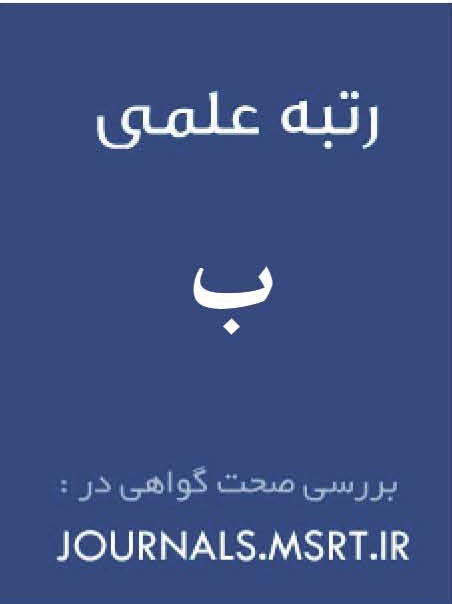طراحی الگوی زنجیره ارزش بانک تجارت مبتنی بر استراتژیهای بازاریابی
کلمات کلیدی:
زنجیره ارزش, بانک تجارت, استراتژی های بازاریابیچکیده
توسعه استراتژیهای مؤثر و رقابتپذیری در بازارهای مالی امری حیاتی است. لذا هدف اصلی این پژوهش، طراحی و اعتبار سنجی الگوی زنجیره ارزش بانک تجارت مبتنی بر استراتژیهای بازاریابی است. پژوهش حاضر از نظر روش کیفی و از نظر چگونگی تحلیل دادهها توصیفی – اکتشافی با روش تحلیل مضمون میباشد. ابزار مورد استفاده در این تحقیق مصاحبه عمیق (نیمه ساختاریافته) است. جامعه آماری مشتمل بر 10 نفر از متخصصان و خبرگان حوزه بازارایابی میباشند. در این پژوهش اعضاء پنل خبرگان با استفاده از رویکرد نمونه گیری هدفمند گزینش گردیدند؛ کدهای کلیدی پس از مطالعه و استخراج با استفاده از رویکرد تحلیل مضمون با استفاده از نرم افزار مکس کیودا مورد تحلیل قرار گرفتند. اعتبار نتایج پژوهش با استفاده از معیارهای کرسول (2002) مورد سنجش و تأیید قرار گرفت. براساس نتایج حاصل از این پژوهش، با بررسی دستهبندی کدهای توصیفی حاصل از متون مصاحبه، 42 مضمون سازنده شناسایی شد و با توجه به شباهت و قرابت معنایی آنها، در 6 مضمون فراگیر شامل: تحلیل و تصمیمسازی دادهمحور، فناوریهای تحولآفرین بانکی، نوآوری در الگوهای درآمدزایی بانکی، تجربه دیجیتال مشتری، بانکداری دوستدار محیطزیست، معماری خدمات بانکی تحلیل و تصمیمسازی دادهمحور، فناوریهای تحولآفرین بانکی، نوآوری در الگوهای درآمدزایی بانکی، تجربه دیجیتال مشتری، بانکداری دوستدار محیطزیست، معماری خدمات بانکی دستهبندی شدند.
دانلودها
مراجع
Abedin, M. Z., Hajek, P., Sharif, T., Satu, M. S., & Khan, M. I. (2023). Modelling bank customer behaviour using feature engineering and classification techniques. Research in International Business and Finance, 65, 101913. https://doi.org/10.1016/j.ribaf.2023.101913
Alenizi, A., Mishra, S., & Baihan, A. (2024). Enhancing secure financial transactions through the synergy of blockchain and artificial intelligence. Ain Shams Engineering Journal, 15(6), 102733. https://doi.org/10.1016/j.asej.2024.102733
Ali, A., Abd Razak, S., Othman, S. H., Eisa, T. A. E., Al-Dhaqm, A., Nasser, M., Elhassan, T., Elshafie, H., & Saif, A. (2022). Financial fraud detection based on machine learning: a systematic literature review. Applied Sciences, 12(19), 9637. https://doi.org/10.3390/app12199637
Amuakwa-Mensah, F., & Näsström, E. (2022). Role of banking sector performance in renewable energy consumption. Applied Energy, 306, 118023. https://doi.org/10.1016/j.apenergy.2021.118023
Azmi, W., Hassan, M. K., Houston, R., & Karim, M. S. (2021). ESG activities and banking performance: International evidence from emerging economies. Journal of International Financial Markets, Institutions and Money, 70, 101277. https://doi.org/10.1016/j.intfin.2020.101277
Babaadi Akasheh, M., Abbasi, A., & Ranaii Kordshooli, H. (2022). Designing a Model for Banking Service Value Chain with an Emphasis on Customer-Centric Approach. Journal of Business Management Explorations, 14(28), 171-202.
Bansal, P. (2024). BAAS: Banking as a service brings Industry disruption. International Journal of Science and Research Archive, 13(1), 1258-1263. https://doi.org/10.30574/ijsra.2024.13.1.1708
Bhat, S. A., Islam, S. B., & Mir, M. F. (2024). Consumers' attitude toward biometric banking services: an empirical evaluation of determinants and outcomes. Journal of Financial Services Marketing, 29(4), 1572-1588. https://doi.org/10.1057/s41264-024-00291-7
Central Bank of the Islamic Republic of, I. (2022). Macro Policies of Resistance Economy in the Banking Sector. Tehran: Central Bank of the Islamic Republic of Iran.
Cornelli, G., Frost, J., Gambacorta, L., Rau, P. R., Wardrop, R., & Ziegler, T. (2023). Fintech and big tech credit: Drivers of the growth of digital lending. Journal of Banking & Finance, 148, 106742. https://doi.org/10.1016/j.jbankfin.2022.106742
Cowan, G., Mercuri, S., & Khraishi, R. (2023). Modelling customer lifetime-value in the retail banking industry. arXiv preprint. arXiv:2304.03038
Grijalvo, M., & García-Wang, C. (2023). Sustainable business model for climate finance: Key drivers for the commercial banking sector. Journal of Business Research, 155, 113446. https://doi.org/10.1016/j.jbusres.2022.113446
Gupta, A. (2019). Data Mining for Risk Assessment in Banking and Finance: A Review. Turkish Journal of Computer and Mathematics Education (TURCOMAT), 10(1), 568-574. https://doi.org/10.17762/turcomat.v10i1.13550
He, J., & Zhang, S. (2022). How digitalized interactive platforms create new value for customers by integrating B2B and B2C models? An empirical study in China. Journal of Business Research, 142, 694-706. https://doi.org/10.1016/j.jbusres.2022.01.004
Hornuf, L., Klus, M. F., Lohwasser, T. S., & Schwienbacher, A. (2021). How do banks interact with fintech startups? Small Business Economics, 57, 1505-1526. https://doi.org/10.1007/s11187-020-00359-3
Hung, J. L., He, W., & Shen, J. (2020). Big data analytics for supply chain relationship in banking. Industrial Marketing Management, 86, 144-153. https://doi.org/10.1016/j.indmarman.2019.11.001
Ioannou, I., & Demirel, G. (2022). Blockchain and supply chain finance: a critical literature review at the intersection of operations, finance and law. Journal of Banking and Financial Technology, 6(1), 83-107. https://doi.org/10.1007/s42786-022-00040-1
Kokkalakonda, N. (2022). Personalized Banking: Leveraging AI and Machine Learning for Customer-Centric Financial Services. International Journal of Science and Research Archive, 6(2), 166-173. https://doi.org/10.30574/ijsra.2022.6.2.0214
Kumar, R. (2022). Role of Blockchain in Revolutionizing Online Transactional Security. arXiv:2206.04141
Lemon, K. N., & Verhoef, P. C. (2016). Understanding Customer Experience Throughout the Customer Journey. Journal of Marketing, 80(6), 69-96. https://doi.org/10.1509/jm.15.0420
Long, G., Tan, Y., Jiang, J., & Zhang, C. (2020). Federated learning for open banking Federated learning: privacy and incentive. Springer International Publishing. https://doi.org/10.1007/978-3-030-63076-8_17
Lusch, R. F., & Vargo, S. L. (2014). The service-dominant logic of marketing: Dialog, debate, and directions. Routledge. https://doi.org/10.4324/9781315699035
Mehmood, U. (2023). Environmental sustainability through renewable energy and banking sector development: policy implications for N-11 countries. Environmental Science and Pollution Research, 30(9), 22296-22304. https://doi.org/10.1007/s11356-022-23738-7
Morgan-Thomas, A., Dessart, L., & Veloutsou, C. (2020). Digital ecosystem and consumer engagement: A socio-technical perspective. Journal of Business Research, 121, 713-723. https://doi.org/10.1016/j.jbusres.2020.03.042
Mukerjee, K. (2024). Augmented reality and customer engagement in the context of e-banking. Journal of Financial Services Marketing, 29(4), 1559-1571. https://doi.org/10.1057/s41264-024-00284-6 10.1057/s41264-024-00290-8
Pal, R. (2024). Revolutionizing Cloud Security- Big Data Dynamic Ownership and Robust Data Deduplication in Storage Solutions. https://doi.org/10.55524/csistw.2024.12.1.45
Polireddi, N. S. A. (2024). An effective role of artificial intelligence and machine learning in banking sector. Measurement: Sensors, 33, 101135. https://doi.org/10.1016/j.measen.2024.101135
Psychoula, I., Gutmann, A., Mainali, P., Lee, S. H., Dunphy, P., & Petitcolas, F. (2021). Explainable machine learning for fraud detection. Computer, 54(10), 49-59. https://doi.org/10.1109/MC.2021.3081249
Rahman-Seresht, H., Khashaei Varnamkhasti, V., Ebrahimi, M., & Rahimian, M. (2018). A Model of Strategic Value Co-Creation in Iran's Banking Industry: Value Creation in a New Paradigm. Journal of Public Administration Research, 11(40), 27-52.
Riikkinen, M., & Pihlajamaa, M. (2022). Achieving a strategic fit in fintech collaboration: A case study of Nordea Bank. Journal of Business Research, 152, 461-472. https://doi.org/10.1016/j.jbusres.2022.05.049
Silva, F., Ferreira, A., & Cortez, M. C. (2023). The performance of green bond portfolios under climate uncertainty: A comparative analysis with conventional and black bond portfolios. SSRN. https://doi.org/10.2139/ssrn.4359912
Stavropoulou, E., Spinthiropoulos, K., Garefalakis, A., Ragazou, K., & Gonidakis, F. (2023). The role of social banking in the success and sustainable business continuity of SSMEs. International Journal of Financial Studies, 11(3), 86. https://doi.org/10.3390/ijfs11030086
Stefanelli, V., & Manta, F. (2023). Digital financial services and open banking innovation: are banks becoming 'invisible'? Global Business Review, 09721509231151491. https://doi.org/10.1177/09721509231151491
Tai, L. Q., & Huyen, T. T. (2019). Deep Learning Techniques for Credit Scoring. Journal of Economics, Business and Management, 7(3), 93-96. https://doi.org/10.18178/joebm.2019.7.3.588
Tanimori, M. (2021). Research on Pricing by Subscription-Model: Simulation of Application to the Bank Account Fees. The Journal of Management Accounting, Japan, 29(1), 91-108.
Teece, D. J. (2018). Business models and dynamic capabilities. Long Range Planning, 51(1), 40-49. https://doi.org/10.1016/j.lrp.2017.06.007
Tejarat, B. (2023). Annual Performance Report of Tejarat Bank. https://tejaratbank.ir/news/2129258-tejaratbank.html
Vargo, S. L., & Lusch, R. F. (2004). Evolving to a New Dominant Logic for Marketing. Journal of Marketing, 68(1), 1-17. https://doi.org/10.1509/jmkg.68.1.1.24036
Wiethölter, J., Salingré, J., Feldmann, C., Schwanitz, J., & Niessing, J. (2023). Exploring Customer Journey Mining and RPA: Prediction of Customers' Next Touchpoint. International Conference on Business Process Management, https://doi.org/10.1007/978-3-031-43433-4_12
Zhang, Z., Zohren, S., & Roberts, S. (2020). Deep learning for portfolio optimization. arXiv preprint. https://doi.org/10.2139/ssrn.3613600
Zhou, L., Chen, M., & Lee, H. (2022). Supply Chain Finance: A Research Review and Prospects Based on a Systematic Literature Analysis from a Financial Ecology Perspective. Sustainability, 14(21), 14452. https://doi.org/10.3390/su142114452
دانلود
چاپ شده
ارسال
بازنگری
پذیرش
شماره
نوع مقاله
مجوز
حق نشر 1404 Mohammad Sadegh Sanaeirad, Mehdi Mahmodzadeh Vashan, Hossein Hakimpour (Author)

این پروژه تحت مجوز بین المللی Creative Commons Attribution-NonCommercial 4.0 می باشد.









